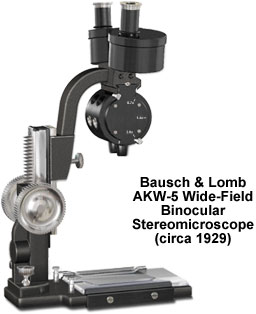Bausch & Lomb AKW-5 Wide-Field Binocular Stereomicroscope
According to the 1929 Bausch & Lomb microscope catalog, the KW wide-field binocular stereomicroscope is "one of the most valuable all around microscopes ever produced". The AKW-5 model illustrated below, redrawn from photographs of the original microscope, features extremely wide fields, long working distances, parfocal objectives, high eye points, stereoscopic vision, and an erect image that is not reversed.

The wide viewfield and long working distance combine for much easier manipulation of large specimens. These optical instruments can accommodate Petri dishes, tissue culture vessels, or chemical flasks, while also permitting dissections. Advantageous because they enable an exceedingly wide field to be viewed (for the period), the matched pair of high eye point oculars (10x or 15x) also allows visually deficient microscopists to view specimens without removing their eyeglasses. Perception of a three-dimensional specimen is important in dissections, and the stereoscopic effect also proves useful in raw materials and product inspections associated with textiles and other industries.
The AKW-5 stereomicroscope helped make Bausch & Lomb a leader among high-quality optical instrument manufacturers during the 1920s and 1930s. Unlike the conventional Greenough design, the compound AKW-5 binocular microscope creates images of the specimen that are neither inverted nor reversed. These improvements nearly eliminate the difficulties and damaged specimens associated with dissections and other manipulations undertaken with previous designs. The older configuration of the Greenough-type binocular microscopes requires the operator to continuously be aware of the real specimen orientation and how it differs from what is imaged, leading to stress, fatigue, and critical errors.
The patented drum nosepiece contains three pairs of parfocal objectives (magnifications ranging from 0.7x to 2.0x), which are easily rotated into place. Although the paired objectives are permanently mounted, individual centering on the nosepiece is accommodated. The Bausch & Lomb Stand A fits directly over a specimen, so that large objects may be examined. For smaller specimens, a clear glass stage is used. There are two other stand designs and several optional accessories available in the KW line of stereomicroscopes. Alternative stand selection depends on if the specimens are transparent or whether the observations are for anatomical, geological, or metallurgical work.
BACK TO TWENTIETH CENTURY BAUSCH & LOMB MICROSCOPES
BACK TO TWENTIETH CENTURY MICROSCOPES
